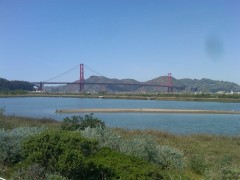When I get to thinking of the global warming and energy crisis, I can’t help but feel that it’s nothing short of irresponsible for energy innovation not to be on the agenda of every large corporation in the world.
O’Reilly, trend-setters in the realm of innovative conferences (O’Reilly Emerging Technology, O’Reilly Emergying Telephony, Web 2.0 Summit and Expo, and more), would seem to agree. They are at it again, this time – for the first time – with the O’Reilly Energy Innovation Conference, coming to San Francisco in August this year.
Some highlights of the planned event, which “grows at the intersection of technology and energy,” are, and I quote:
- High profile keynote presentations with big players and up-and-coming innovators
- Concrete, qualitative discussions helping to focus on what is viable now and in the coming, critical decade
- Launch Pad, an introduction to cool startups, applications, and products
- Energy Innovation Fair, an evening event that brings together projects, tools, apps, and other innovative technology being created in garages, workshops, and university labs that offer insight into what the future of power and energy will hold
- Emerging technologies, ranging from smart buildings and plug-in hybrid vehicles to superconductors and enormous wind turbines, are shaping a transformation in our economy and our lives
- Radical new tools for increasing supplies and mitigating environmental impacts
Sayeth O’Reilly himself of the event:
“Power is going to be a major focus of thought and investment, and it’s going to touch everything. So pulling together people from all these overlapping fields, who would normally hang with their own birds but not those of a similar feather, suddenly make sense.”
Co-chairs include an engineering manager and engineering director from Google:
- Alec Proudfoot seems to be an alternate-fuel vehicle visionary of sorts. He created the prototype for what became “the first modern high power AC induction electric vehicle,” and does stuff with Google Book Search and Google Maps – as well as advises Google.org on energy and transportation issues “in his 20% time.”
- Chris Uhlik’s career has covered robotics, electronics, software, power systems, and automotive controls – as well as Gmail and Google Book Search.
So why would my company, SAP, take notice?
- If O’Reilly’s got it on its radar, I take notice.
- Google’s got it on its radar, anyway…
- Doesn’t SAP have an interest in the global supply chain?
- A different kind of regreening: energy issues will change the world’s economy
- Not to mention – energy issues will change the world
- Innovation comes from everywhere …
- Couldn’t the sharpest minds at SAP help engage in “increasing supplies and mitigating environmental impacts”?
And on that last point, I got to thinking about knives.
While on my couch attempting to beat a cold yesterday, I read an article in the March/April 2007 edition of Cook’s Illustrated on the latest innovations in knives. It caught my eye for two reasons:
1) In thinking about innovation for work, I seem to notice that innovation is key now in every industry (even – maybe especially – in the fast food arena – witness Taco Bell: “Think outside the bun”) – and knife making is no exception. Think about the size of blade – who knew that a blade that is more narrow on the top (non-sharp) part has therefore a more narrow profile overall, and instead of “wedging” the food apart and perhaps tearing it, simply slices cleanly through? And what about the shape and material of the handle, and where your thumb is going to sit? Think about how you rock your wrist during cutting – ergonomics, and whether the handle will slip out of your hands when your hands are wet or greasy. And how often have you been irked by the carrots or potatoes sticking to the blade as you chop – and did you know that this can be mitigated with coating or indents on the blades?
Tons of innovation there – who knew? And – how did they know?
2) Who’s one of the current knife innovators? Porsche. While its knife is not ranked very high by the staff at Cook’s, it is interesting to note instances of a company innovating outside its best-known product. Perhaps they had a lot of leftover chrome.
But – sharp minds and puns aside – I do get to thinking – what in fact DOES the regreening of the globe have to do with SAP, and – more relevantly – what will SAP have to do with it?
Postscripts 2012:

